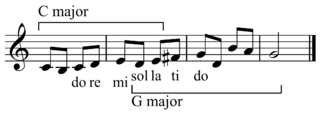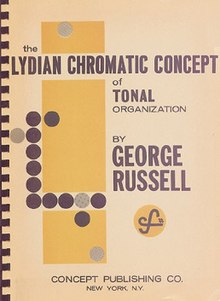Deriving Lydian
Russell believed that dominant function was the driving force behind all harmonic motion. Russell focuses on the Lydian mode because it can be built with fifths. For instance, to construct a C Lydian scale one could list the first seven tones on the circle of fifths starting with C, the desired Lydian Tonic. This process would yield C, G, D, A, E, B, F♯. If these tones are voiced in the space of an octave, they form the Lydian mode (C, D, E, F♯, G, A, B). [2] Additionally, Russell observed, when these tones are voiced in thirds they form the preferred form of a major 13 (#11) chord. [3]
The Lydian Chromatic Scale
Russell builds a prototype chromatic scale starting on the Lydian Tonic by stacking fifths, skipping the interval between the seventh and eighth tones, and placing the skipped tone at the end for having the lowest level of tonal gravity. Using C as the Lydian Tonic yields the following 12-note scale with enharmonic respellings: C, G, D, A, E, B, F♯, G♯, E♭ (D♯), B♭ (A♯), F (E♯), D♭ (C♯). Thus the Lydian Chromatic Scale and all its derivatives contain only Pythagorean intervals. [4]
In music theory, the term mode or modus is used in a number of distinct senses, depending on context.

The major scale is one of the most commonly used musical scales, especially in Western music. It is one of the diatonic scales. Like many musical scales, it is made up of seven notes: the eighth duplicates the first at double its frequency so that it is called a higher octave of the same note.
An altered chord is a chord that replaces one or more notes from the diatonic scale with a neighboring pitch from the chromatic scale. By the broadest definition, any chord with a non-diatonic chord tone is an altered chord. The simplest example of altered chords is the use of borrowed chords, chords borrowed from the parallel key, and the most common is the use of secondary dominants. As Alfred Blatter explains, "An altered chord occurs when one of the standard, functional chords is given another quality by the modification of one or more components of the chord."
In jazz, the altered scale, altered dominant scale, or Super Locrian scale is a seven-note scale that is a dominant scale where all non-essential tones have been altered. This means that it comprises the three irreducibly essential tones that define a dominant seventh chord, which are root, major third, and minor seventh and that all other chord tones have been altered. These are:
In musical tuning, the Pythagorean comma (or ditonic comma), named after the ancient mathematician and philosopher Pythagoras, is the small interval (or comma) existing in Pythagorean tuning between two enharmonically equivalent notes such as C and B♯, or D♭ and C♯. It is equal to the frequency ratio (1.5)12⁄27 = 531441⁄524288 ≈ 1.01364, or about 23.46 cents, roughly a quarter of a semitone (in between 75:74 and 74:73). The comma that musical temperaments often "temper" is the Pythagorean comma.

In music, modulation is the change from one tonality to another. This may or may not be accompanied by a change in key signature. Modulations articulate or create the structure or form of many pieces, as well as add interest. Treatment of a chord as the tonic for less than a phrase is considered tonicization.
Modulation is the essential part of the art. Without it there is little music, for a piece derives its true beauty not from the large number of fixed modes which it embraces but rather from the subtle fabric of its modulation.

In music theory, the circle of fifths is a way of organizing the 12 chromatic pitches as a sequence of perfect fifths.. If C is chosen as a starting point, the sequence is: C, G, D, A, E, B, F♯, C♯, A♭, E♭, B♭, F. Continuing the pattern from F returns the sequence to its starting point of C. This order places the most closely related key signatures adjacent to one another. It is usually illustrated in the form of a circle.
In music theory, an augmented sixth chord contains the interval of an augmented sixth, usually above its bass tone. This chord has its origins in the Renaissance, was further developed in the Baroque, and became a distinctive part of the musical style of the Classical and Romantic periods.
Chromaticism is a compositional technique interspersing the primary diatonic pitches and chords with other pitches of the chromatic scale. In simple terms, within each octave, diatonic music uses only seven different notes, rather than the twelve available on a standard piano keyboard. Music is chromatic when it uses more than just these seven notes.
The modern Lydian mode is a seven-tone musical scale formed from a rising pattern of pitches comprising three whole tones, a semitone, two more whole tones, and a final semitone.

George Allen Russell was an American jazz pianist, composer, arranger and theorist. He is considered one of the first jazz musicians to contribute to general music theory with a theory of harmony based on jazz rather than European music, in his book Lydian Chromatic Concept of Tonal Organization (1953).

A heptatonic scale is a musical scale that has seven pitches, or tones, per octave. Examples include:

In music theory, the harmonic major scale is a musical scale found in some music from the common practice era and now used occasionally, most often in jazz. In George Russell's Lydian Chromatic Concept it is the fifth mode (V) of the Lydian Diminished scale. It corresponds to the Raga Sarasangi in Indian Carnatic music, or Raag Nat Bhairav in Hindustani music.
Pitch axis theory refers to a way of thinking about chord progressions and modes, that was heavily used and popularized by the guitarist Joe Satriani.
In music, polymodal chromaticism is the use of any and all musical modes sharing the same tonic simultaneously or in succession and thus creating a texture involving all twelve notes of the chromatic scale. Alternately it is the free alteration of the other notes in a mode once its tonic has been established.
In music, the axis system is a system of analysis originating in the work of Ernő Lendvai, which he developed in his analysis of the music of Béla Bartók.
In music, the major Locrian scale, also called the Locrian major scale, is the scale obtained by sharpening the second and third notes of the diatonic Locrian mode. With a tonic of C, it consists of the notes C D E F G♭ A♭ B♭. It can be described as a whole tone scale extending from G♭ to E, with F introduced within the diminished third interval from E to G♭. The scale therefore shares with the Locrian mode the property of having a diminished fifth above the tonic.
In music, harmonization is the chordal accompaniment to a line or melody: "Using chords and melodies together, making harmony by stacking scale tones as triads".
The chord-scale system is a method of matching, from a list of possible chords, a list of possible scales. The system has been widely used since the 1970s.
This page is based on this
Wikipedia article Text is available under the
CC BY-SA 4.0 license; additional terms may apply.
Images, videos and audio are available under their respective licenses.









